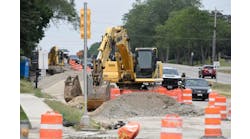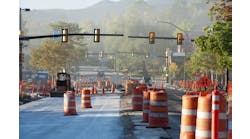Nothing was to be hit hard on the ground or in the air—and the local Little League was cool with it. So were hundreds of thousands of commuters and residents.
The South Bay Expressway project, which ran through San Diego and Chula Vista, Calif., tiptoed around one of the most environmentally sensitive areas on the West Coast to create little disturbance during the construction of a four-lane highway, which included the erection of one of the tallest and longest bridges in southern California. In the end, not only did it protect and enhance the life of the likes of the Quino checkerspot butterfly, the coastal cactus wren, the Otay tarplant and the California gnatcatcher, but also it redefined how a community should be shaped.
“I think it is really exciting,” Laurie Berman, project manager for Caltrans, told Roads & Bridges. “I started on this project when it was still going through the environmental studies. It was an exciting project to me every day, and it has been really exciting since it opened to see what a difference it has made for the people who are using it. I hear that a lot.”
The continued excitement cannot be contained, as the South Bay Expressway project was named No. 1 on the Roads & Bridges 2008 Top 10 Roads list. What was done outside the ordinary lines of road construction hoisted South Bay above the rest. The project includes a wide range of habitat preservation measures, including the purchase of more than 1,500 acres to house sensitive species. The South Bay Expressway project went as far as to fund a captive breeding and genetic study for the checkerspot butterfly, and when the first of the famous series of San Diego wildfires swept through the area, parts had to be restored all over again. One of the offsite mitigation sites burned. It was habitat that consisted of maritime succulent scrub and was used by the wren. Crews were successful in replacing the scrub by revegetating at the same time they were constructing erosion-control measures.
Human life was enhanced with the construction of a modern Little League complex, which included six fields, artificial turf, electronic scoreboards and meeting rooms, recreation centers and a water play facility, room for additional camping spots and the preservation and addition of recreational trails. The Summit Meadows Regional Park also is in the process of being expanded.
In all over 17 different alignments were studied, and the one chosen is successfully moving thousands of commuters daily. Before construction, congestion strapped Otay Mesa, the eastern portion of the city of Chula Vista and the Bonita area of San Diego County.
“When we started the design process, our offices were moved down there and I was moving in the opposite direction [of the commuter rush],” said Berman. “I would look over at everyone trying to head north in the morning and it was pretty horrendous.”
The project, however, never looked better for private investors. Part of a pilot project conducted by the state of California in the late 1990s, the South Bay Expressway was one of four being offered statewide to the right suitor. Three key elements separated the South Bay from the rest. The first was the fact that the interchange on the northern end of the project was already funded by Caltrans.
“The private sector felt it could fund the toll road itself, but the interchange would not pencil out,” said Berman.
Private investors were free to pencil in design-build construction, which typically requires special legislation in California. Property owners also were willing to donate property for the toll road construction, which perhaps sealed the deal. In the end, the South Bay Expressway and the Rte. 91 Express Lanes were the only two pilot projects purchased by private bidders.
Asphalt pavement was the material of choice for the over 9 miles of toll road construction. Crews laid down pavement that was 9 in. thick over 23 in. of Class II aggregate base. The asphalt mix consisted of ¾-in. Type A aggregate and a PG 64-10 binder. Air voids varied from 4 to 6%, and the contractor achieved a minimum density of 96%. The highway also features maintenance vehicle pullouts, which essentially are wider shoulders that allow workers to park farther away from traffic. In addition, access roads were constructed for maintenance and operational staff to safely reach various road components.
“That is an important element with all of our designs—to make sure that beyond construction it works for motorists and that it is safe for workers,” said Berman. “Whatever we can do to minimize their exposure to traffic is considered right from the design stage.”
The centerpiece of the project was the 180-ft-tall Otay River Bridge, a precast segmental span that hangs over the environmentally challenged Otay River Valley. To minimize the construction footprint, it was decided to ship the individual segments of the superstructure in from Pomeroy in Lake Peris, Calif., which was 180 miles from the jobsite. The precast pieces were cast with high-early-strength concrete and were steam-cured for the first 12 hours en route to reaching a required 2,500 psi. A concrete strength of 4,000 psi was called for prior to lifting the segments, which happened within four days of the pour. Pieces were designed to hit a 28-day strength of 5,500 psi, and Berman said some were as high as 7,000 psi.
A total of 640 segments were placed by a launching truss. The piers of the project were cast in place, and each had continuous footings with 6-ft-diam. CIDH piles reaching an average depth of 85 ft.
The project set out to minimize water quality impacts by using all available space—loop interchange ramps, medians, under bridges—to create a dozen water detention basins. Crews were required to comply with the provisions of the Clean Water Act and treat over 90% of the runoff on site.
To blend in more of the scenery, approximately 38,000 sq yd of earth berms were used to block the view of the highway from sensitive locations, and “dry stack” architectural treatments were used to provide the appearance of stacked rock on hardscape surfaces.


